Coating defects
Below we have compiled a list of the most common mistakes made during painting and coating. You will find the possible causes of the mistakes and tips on how to avoid them.

Assistance
Flaking, peeling
Cause
- unsuitable coating system (lean on fat)
- Change of the substrate

Swelling, margin marks
Cause
- Substrate reversible or not cured
- Prematerials revised too early
- Layer thicknesses too high
- too short drying times
- sandpaper too coarse
Avoidance
- Solvent test
- Filler only on bare sheet metal
- Insulate with a 2-component filler; spray the filler in several thin coats and observe flash-off times.
- Ensure proper drying of the starting materials
- do not grind too roughly
- Observe processing instructions

Wetting disorder
Cause
- Silicone contamination (e.g. hand cream, welding spray, neon tubes, sealants containing silicone, etc.)
- residues containing oil, wax, grease
- Spray air contaminated by condensation or oil residues
- Dust incidence
- Dew fall and moisture exposure during drying and curing
- Exhaust air time too short during heat curing
Avoidance
- silicone-free hand creams (Stokolan)
- extreme cleanliness (when processing hammertype coatings complete separation incl. wash thinner!)
- careful cleaning of the substrate before starting the painting process
- regular maintenance of the spraying equipment
Bubble formation
Cause
- Residues of chemical pretreatment of sheet metal
- Substrate not sufficiently dried out and cleaned
- Pores/voids not sanded out
- Polyester materials not insulated
- Spray air contaminated
- Condensation due to temperature fluctuations
- Hand sweat
- Salts and minerals in grinding water
- Influence of humidity during filming
- Inclusions from porous substrate
- Too short flash-off time for baking enamels
- Lack of primer
Avoidance
- Allow pre-materials to dry out well, careful cleaning of the substrate
- Polyester products insulate
- Carefully grind out or fill in shrinkage marks
- Avoid condensation
- Ensure clean spray air, regularly check oil and water separators.
- Use deionized water for cleaning

Bluish shimmer on the surface and haze formation
Cause
- Influence by interfering substances from the subsurface
- Excessive humidity during drying/curing
- insufficient ventilation during drying/ curing
- Condensate precipitation
sediment
Cause
- Exceeding the storage time
- not stirred or not stirred sufficiently

Opacity, hiding power, missing(s)
Cause
- no correct, uniform base
- not sufficiently stirred
- layer thickness too low
- Viscosity too low
Avoidance
- also stir vertically
- Process viscosity and film thickness according to specifications
- use light background/ primer
- Spray neutral substrate
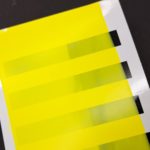
Nozzle clogging, turbidity
Cause
- Paint contamination
- incompatible addition of paint or thinner
Avoidance
- work cleanly, material if necessary. sieve
- Mix only compatible coatings and thinners
Thickening, gelling
Cause
- Exceeding the pot life

Colour deviations
Cause
- sprayed too wet, too dry, too thin, too opaque
- Spray gun (nozzle), spray pressure not according to regulations
- Surface weathered by environmental influences
- Deviation in the series painting (multiple shades)
- Substrate is too dark, e.g. with lead-free top coats (red, yellow, orange)
- not sufficiently stirred
Avoidance
- Use recommended primer
- Color comparison (sample sheet)
- Coating “droplet method
- Stir not only horizontally, but also vertically (if necessary, mechanically with compressed air stirrer).
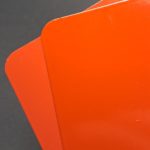
Staining (yellow to brown)
Cause
- Peroxide residues in the wood (from bleaching)
Avoidance
- Allow peroxide to completely decompose by heat or ammonia before painting
- Use suitable hardener
Fullness insufficient
Cause
- absorbent substrate
- layer thickness too low
Gloss loss
Cause
- absorbent substrate
- Exposure of fresh coating to moisture (white tint at higher temperature and humidity)
- Too high pigment content due to inadequate agitation
- Disturbances during drying and curing of the coating
Adhesion problems
Cause
- Substrate not sufficiently pretreated
- Condensation due to temperature fluctuations / dew point undershoot
- wrong paint system
- drying times / flash-off times too short
- insufficient dissolving of the substrate due to exceeding the recoat time (especially with 2C-EP and PU systems)
Avoidance
- Observe manufacturer information
Adhesion problems of the clear coat
Cause
- Too high film thickness of the basecoat
- too short intermediate and final flash-off times of the basecoat
- Incorrect mixing ratio of clearcoat/hardener
- poor intercoat adhesion
Avoidance
- Adhere to the layer thicknesses of the basecoat according to the product information.
- Observe the intermediate and final flash-off times specified in the product information.
- Observe mixing ratio of clearcoat to hardener according to product information.
Adhesion problems on plastic
Cause
- insufficient cleaning, drying (annealing)
- unsuitable adhesion promoter
Avoidance
- anneal before cleaning
- thorough cleaning
- Evaporation of the cleaning agent
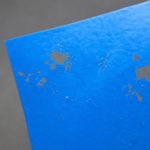
Skin formation
Cause
- improper storage
Pull up
Cause
- Grinding through to the substrate
- Not isolated
- Insulated with unsuitable filler
- Filler not processed according to instructions
- Substrate not thoroughly dried
Avoidance
- Solvent test
- Insulate with a 2-component filler; spray the filler in several thin coats and observe flash-off times.
- Avoid cut-throughs
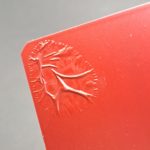
Clear coat yellowing
Cause
- incorrect hardener
Avoidance
- Close hardener container after use
- Mixing ratio clearcoat / hardener according to product information
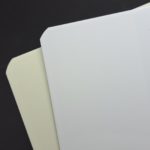
Curling
Cause
- not fully cured pre-paint, e.g. fresh synthetic resin paints
- Unsuitable substrate, e.g. non-solvent-resistant plastics
- Too thick layers
Avoidance
- Observe prescribed drying times
- remove or isolate solvent-sensitive substrates
Runner or curtain formation
Cause
- deviating spray viscosity, spray technique, intermediate flash-off times and layer thicknesses
- Spray gun (nozzle), spray pressure not correct
- Paint material, substrate or room temperature too cool
- Incorrect dilution or viscosity too low
- Substrate has loosened
Avoidance
- Processing according to manufacturer’s instructions
- use proper spraying equipment
- Heat object and material to room temperature of 20 °C
- Select good combination of hardener/thinner
Pinpricks
Cause
- Substrate not sufficiently dried out
- Polyester materials not insulated
- Pores not ground out
Avoidance
- Allow starting materials to dry out well
- Sand or fill pores well

Optics (unclean appearance of the coating)
Cause
- insufficient preparation of the substrate
- Dust incidence
- unclean working equipment
Cracking
Cause
- Change of the substrate
- unsuitable coating system (lean on grease / primer on paint)
- Incorrect pretreatment of the substrate
- Layer thicknesses too high
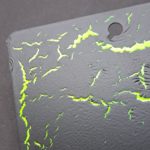
Wrinkling
Cause
- Layers too thick with surface drying too fast
- Swelling of coatings by water or solvents
- pull up (overpainting too early or too late especially with alkyd systems)

Grinding grooves
Cause
- sanding with too coarse sandpaper
- soft, elastic substrates
- Top coat applied too thinly
Avoidance
- Solvent test
- Isolate the soft ground
- Use specified abrasive paper
- Apply normal layer thickness

Striping
Cause
- Spray viscosity, spray pressure, spray technique
- Spray gun, spray nozzle
- too short flash-off times
- Unsuitable processing temperature
- Unsuitable thinners
Avoidance
- Observe processing instructions according to product information
- Select suitable spray gun and spray nozzle
- Guide the spray gun parallel to the object
- Remain in the manufacturer’s product system
Drying / curing problems
Cause
- climatic influences
- wrong hardener addition
- Too thick layers
- Inadequate substrate pre-treatment
- Plasticizer migration
Processability poor
Cause
- Unsuitable viscosity
- unsuitable solvents
- unfavorable temperature of the substrate and the coating material
Discolouration
Cause
- Bleed-through of bitumen, organic pigments and dyes
- Yellowing with phenolic coatings
- Effects of light and industrial waste gases on pigments
- Overburning with thermosetting coatings
Yellowing
Cause
- incorrect hardener
Avoidance
- Observe data on product information

Course disorders / orange peel
Cause
- deviating spray pressure, spray viscosity, spray technique, processing temperature
- Unsuitable solvent combination
- scarred underground
- unsuitable spray gun (nozzle)
- too fast drying
- poorly run primer coating
- absorbent substrate
- incorrect processing technique
- No optimal layer thickness
Avoidance
- Observe processing instructions according to product information
- proper surface preparation
- suitable spray gun (nozzle)
- Use prescribed dilution
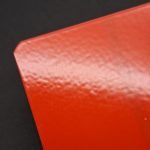
Matting / Gloss
Cause
- Layer thicknesses/ humidity
- Substrate soluble
- Curing error or hardener had already reacted with air humidity
- wrong dilution
- Water or oil in the spray air
- Drying interrupted
- sprayed too dry
Avoidance
- Comply with the specifications on the product information
- Closing hardener cans
- Ensure sufficient fresh air supply
- Do not interrupt forced drying
- Observe drying time
- Use correct dilution
Water bubbles
Cause
- Sanding water residues in corners, edges, folds and under trim strips
- Spray air contaminated
- poor insulation of polyester products
- Humidity too high
Avoidance
- Always dismantle attachments if possible
- carefully blow out
- Check oil and water separators regularly

Water spots
Cause
- freshly painted, not yet cured coating
- layer thickness too high, drying time too short
- Curing error or hardener no longer usable
- Use of unsuitable thinner
Avoidance
- Observe processing instructions according to product information

White tarnishing (especially in thunderstorm climates)
Cause
- Condensation formation in fast-drying NC systems
Avoidance
- Add retarder
Cloud formation
Cause
- deviating spray viscosity, spray technique, flash-off times, spray room temperature
- Spray gun, spray nozzle, spray pressure not correct
- Unsuitable thinner
Avoidance
- Set spray viscosity according to dipstick
- Guide the spray gun parallel to the object
- Select suitable spray gun and nozzle
- Use thinner of the manufacturer
- Observe processing instructions according to product information